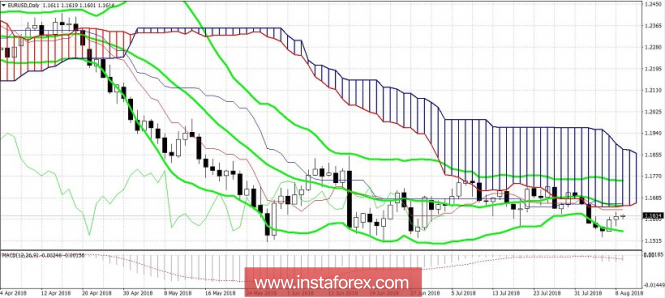The bears of the euro-dollar pair failed to break through the support level of 1.1510 to open the way for a further decline, taking a new price niche in the area of 13-14 figures. As soon as the downward impulse faded, the pair's bulls seized the initiative and returned the price to the 16th figure. However, the growth of the pair also looks uncertain, while the price is below 1.1650. As a result, due to the weakness of both bears and bulls, the pair flew in anticipation of the next news driver.
It should be noted that the European currency reacted relatively calmly to the news that Beijing will introduce additional 25-percent duties on US goods worth $16 billion. We are talking about metal products, oil, medical equipment and cars. The new tariffs will be effective from August 23 – that is, from the same day when Washington will impose duties on Chinese imports in the amount of 25%, in the amount of $16 billion.
Despite the new round of the trade war, the single currency remained almost on the same positions as the dollar. Although earlier the euro had reacted rather painfully to the escalation of the trade conflict, primarily because of the position of the European Central Bank, whose members closely monitor the dynamics of the trade conflict. Most likely, the reason for this stability lies in the latest reports from China. Exports and (especially) imports showed impressive results; China's foreign exchange reserves in July rose by $5.82 billion (instead of the expected decline of $12 billion).); inflation in annual terms is also growing for the third month in a row - published on Thursday, the figure for July was better than forecasts, reaching 2.1%. Also, the yuan, which fell against the dollar since April, suspended its decline.
This situation is holding back the weakening of the European currency, despite the ongoing trade war. Especially against the background of the decline in the dollar index, which in turn reacted to the decline in the yield of 10-year Treasuries. After all, the above-mentioned positive trends are largely offset by the actions of Washington and Beijing. It is obvious that at the moment none of the parties is ready to compromise and sits down at the negotiating table, so we expect more than one series of the US-Chinese "action-series".
However, macroeconomic reports from China play only an indirect role in determining the movement of the euro/dollar pair. On Friday, all the attention of traders of this pair will be focused on the release of data on the growth of US inflation. The consumer price index should show a positive (albeit minimal) trend, rising to 0.2% on a monthly basis and to three percent on an annual basis. The core inflation index is likely to remain at the June level (0.2% mom, 2.3% yoy). If the release comes out at a forecast level, the dollar will get a reason to strengthen – because in this case, the probability of a rate hike in September will approach 100%, and the chances of a December increase will increase again, up to 70-80%.

Here it is worth recalling that at one of the recent Fed meetings, the views of the regulator members were divided: according to some officials, the level of inflation allows further tightening of monetary policy, but, according to their colleagues, the stability of inflation indicators is questionable. In this aspect, Friday's figures will play a special role. Bears of the EUR/USD will be enough if the CPI comes out at least at the forecast level. In turn, the bulls of the pair will be able to seize the initiative if the indicators come out or at the zero level or fall into the negative area. And the negative result of Friday's release will not affect the confidence of the market regarding the September rate hike (this issue is almost resolved) – the subject of discussion will be the possible tightening of monetary policy at the December meeting.
Thus, the data on the growth of US inflation will give another chance to either bulls or bears of the EUR/USD pair to break out of the flat range – that is, to either exceed the level of 1.1650 or to gain a foothold under the mark of 1.1510. If the release will be at the level of forecasts (or the minimum deviation), the pair is likely to remain within this price niche.

But from a technical point of view, everything speaks of the priority of the downward movement. On the daily chart, the pair is under the Kumo cloud of the Ichimoku Kinko Hyo indicator, which formed a bearish "Parade of lines" signal. In addition, the price is located between the average and the lower lines of the Bollinger Bands indicator, which also indicates a downward movement. The nearest support level is 1.1510 (the lower line of the above indicator). The resistance level is the price of 1.1650 - the lower boundary of the Kumo cloud (on D1), which coincides with the average line of the Bollinger Bands indicator and with the Tenkan-sen line.
The material has been provided by InstaForex Company - www.instaforex.com